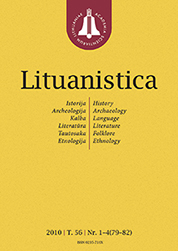LituanisticaWHAT?
 ISSN 0235-716X |
2006 m. Nr. 1 Lietuvos Didžiosios Kunigaikštystės iždo destrukcija XVII a. viduryje
The treasury of the Great Duchy of Lithuania (GDL) in 1618–1667 went through severe trials. At that period, the Lithuanian and Polish Commonwealth had to resist the rebel cosacks headed by Bogdan Chmelnitski, as well as Russian and Swedish invasions. The basic task of the GDL treasury was to finance the protection and defence of the state. The main taxation to supplement the treasury was “padūmė” (“smoke tax”) collected from peasants, citizens and gentry. Besides, part of income into the treasury consisted of new increased import duties, liquor tax, poll-taxes of jews and tatars, as well as quarts, merchants’ donatives. In case of necessity, Seimas would decide to multiply the “padūmė” several times (see Fig. 2, Table 1). The single “padūmė” from the whole GDL would comprise 258.7 thous. ducats. In 1649–1667, 157 “padūmės” were imposed. In 1650, 11 voivode provinces contained about 520 thous. “dūmas” (“smokes”). Their number in the provinces varied (see Fig. 1), most of them being located in the Vilnius, Trakai, Vitebsk, Naugardukas, Brest voivode provinces and Žemaičiai Duchy. From them, the treasury would receive the “padūmė” income (see Fig. 3, Table 2). During the 1654–1667 war, Russia occupied about 80% of the GDL territory. The treasury lost the major part of tax payers. Lots of inhabitants died because of plague outbreaks in 1652–1653. There was a period when the treasury even interrupted its functioning. The single “padūmė” income into the treasury decreased greatly (see Fig. 4, Table 4). The inhabitants were exhausted by incessant and high taxes. To ensure support of the GDL army and the functioning of the treasury, poll taxation was introduced, copper coins were emitted. These means were intended to eliminate treasury destruction.
|
Numeriai:
2011 - T.57 Nr.1, Nr.2, Nr.3, Nr.4 2010 - T.56 Nr.1-4 2009 - T.55 Nr.1-2, Nr.3-4 2008 - T.54 Nr.1, Nr.2, Nr.3, Nr.4 2007 - T.53 Nr.1, Nr.2, Nr.3, Nr.4 2006 Nr.1, Nr.2, Nr.3, Nr.4 2005 Nr.1, Nr.2, Nr.3, Nr.4 2004 Nr.1, Nr.2, Nr.3, Nr.4 2003 Nr.1, Nr.2, Nr.3, Nr.4 2002 Nr.1, Nr.2, Nr.3, Nr.4 2001 Nr.1, Nr.2, Nr.3, Nr.4 |